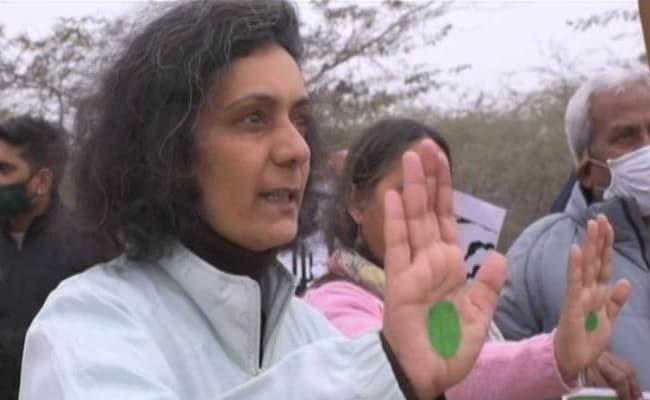Bandhwari Waste-to Energy Plant Triggers Protests in Gurugram

Image Courtesy: Naveen Bharat
New Delhi: Barely 20 kilometers away from Gurugram, among the top 10 most polluted cities in the world, a waste-to-energy plant has been proposed near a landfill in Bandhwari area by the Haryana government.
However, the move has led to several protests and questions being raised over corporate interest in the region.
Citizen groups in the Aravallis have been fighting a lone battle to ensure that green cover is maintained in the area, with protests and pressure gaining momentum since 2018, leading to the government conducting a public hearing before giving a go-ahead to the waste-to-energy (WTE) plant. However, residents claimed that they did not get advance notice of the public hearing, which was not properly publicised.
This week citizen groups, children and activists based in Delhi, Faridabad and Haryana gathered at the Bandhwari landfill site to raise their objections against the proposed WTE plant.
Environmental activist Bhavreen Kandhari told NewsClick: “WTE plants do not provide a magic solution to our immense waste management and energy shortage problems. Instead, they are expensive and counterproductive, and unsuitable given the composition of our waste, our climate, dependence on livelihoods related to waste and recycling and our laxity in ensuring proper industrial regulation standards are set and adhered to.”
Many local residents allege that the clearances were given arbitrarily as the government promised to waive electricity bills of those who gave consent to the creation of the plant. If the Central government’s guidelines regarding waste were to be followed, only 10-20% of a city's non-recyclable and non-compostable waste should go to a WTE plant or landfill. Therefore, the question of why so much interest has been shown in a plant despite ecological dangers being flagged.
Moreover, the area in which the project was proposed was initially is part of the conservation zone, which was shrunk in 2019, after the Ministry of Environment released its report recommending the exclusion of over 4,000 hectares of land from the conservation zone in Haryana. This land includes the ‘green lungs’ of the state—the Aravallis -- under its ambit. The conservation zone extends to parts of Faridabad and Haryana along with Rajasthan.
The Aravalli forest between Bandhwari and Damdama is rich in wildlife and acts as an animal corridor between Asola Bhatti Wildlife Sanctuary in Delhi and Sariska in Rajasthan.
Speaking to NewsClick, Shalini a resident of the area, said: “The Bandwari landfill is an ecological disaster. The WTE plant gets 2000 tonnes of mixed waste from Gurgaon and Faridabad every day, resulting in ground water leachate pollution. The ash that the plant will generate will add to the already polluted air and will also have heavy metals as mixed waste. This spells disaster for our precious Aravallis, its birds and wildlife.”
WTE plants in Delhi have proven to be an ecological hazard for those living in their vicinities.
Citing the example of one such plant, Kandhari said: “The Okhla WTE is a perfect example of how norms can be twisted at the cost of hundreds and thousands of lives. The non-stop smoke emissions seen in the neighbouring colonies of the Okhla plant say it all. The immediate and severe impact of toxic emissions is felt by residents who live around the plants, but air travels thousands of kilometers taking this poison with it. Moreover, waste ash is transported in open trucks through the city and after the National Green Tribunal order, it is now being dumped just anywhere, severely poisoning soil and underground water. It is also a major threat to the scrap collectors who are getting exposed themselves to poisonous ash as they segregate unburnt metal pieces from this new dump.”
Bandhwari remains to be one of the biggest landfills in Northern India, spread across 32 acre on the Faridabad-Gurugram road, receiving almost 2,000 tonnes of solid waste every day by conservative estimates, from Gurugram and Faridabad. The villagers said they had witnessed instances of health hazards directly relating to the pollution of the groundwater in the area, and fear that the combustion plant could potentially add to their woes.
Read More: 'Aravallis to Be Kept Out of National Conservation Zone to Further Corporate Interests'
Get the latest reports & analysis with people's perspective on Protests, movements & deep analytical videos, discussions of the current affairs in your Telegram app. Subscribe to NewsClick's Telegram channel & get Real-Time updates on stories, as they get published on our website.
























